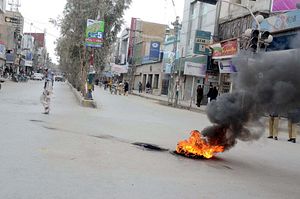When Chinese President Xi Jinping unveiled the blueprint for the enormous $46 billion China-Pakistan Economic Corridor (CPEC) project last year, Pakistan was understandably pleased. The Pakistani government considers the project a game changer for its fragile economic structure. This exhilaration partly stems from the country’s wobbly economic performance in recent years, which has seen it fall short of GDP and other financial targets. The project has also elevated Islamabad’s strategic partnership with the regional superpower. CPEC is viewed as a lifeline for Pakistan, yet three potential obstacles could yet derail this multifaceted project.
Provincial Resentment in Pakistan
A lack of domestic consensus can hinder development in any part of the world, and CPEC is no exception. When CPEC was initially introduced, every mainstream political party supported it, including the ruling Pakistan Muslim League Nawaz (PMLN-N). However, the enthusiasm turned to deep concern when political parties from economically weak provinces (Khyber Pakhtunkhwa and Baluchistan) felt that their province’s reservations about CPEC were not being addressed. This was well described by the Chief Minister of Khyber Pukhtunkhwa Pervez Khattak, who said, “It is not a western route but merely a road, because it has no such infrastructure that would improve the condition of neglected provinces such as KP, Baluchistan and Gilgit-Baltistan.”
Prime Minister Nawaz Sharif has already twice chaired an All Parties Conference to address provincial grievances and has formed a committee to tackle the issues. Regional parties from KPK (Tehreek-i-Insaf, Jamat Islami & Awami National Party) and Baluchistan (Baluchistan National Party-Mengal) have also organized APCs to discuss the provincial concerns. The debate has become so heated that China has felt it necessary to put out a statement urging parties to overcome their differences. A spokesman from the Chinese embassy in Islamabad said: “Relevant parties should strengthen their communication and coordination on the matter.”
Pakistan has a troubling history of ruining big projects through political bickering, and there’s fear that CPEC may meet the same fate. The Kalabagh Dam is a prime example.
The Status of Gilgit-Baltistan
Another aspect that needs to be given close consideration is the status of Gilgit-Baltistan. Pakistan’s claim that it has semi-autonomous control over (Azad) Kashmir is probably not wholly convincing to Chinese authorities. A top Pakistani government official (speaking on condition of anonymity) claimed that “China cannot afford to invest billions of dollars on a road that passes through a disputed territory claimed both by India and Pakistan” This is the reason why, some Gilgit government officials contend, Islamabad is now working to give Gilgit-Baltistan constitutional status by making it the country’s fifth province.
Giving Gilgit provincial status is a bold step. As stated earlier, the region is part of the disputed Jammu & Kashmir territory, and thus India also lays claim to it. Giving it status would require Pakistan to back off a decades-old stance of plebiscite, and would require a disputed territory resolution through the United Nations. Moreover, there are concerns that India, which also claims Kashmir as its integral territory, could also annex it. This scenario has been well described by renowned strategic analyst Ayesha Siddiqa, who states: “If we begin to absorb it so can India. It legitimizes their absorption of the Valley.”
Gilgit-Baltistan is the gateway to Pakistan from China, but there is no proposed hydropower scheme, economic zone, or infrastructure development plan – all of which the region needs. Gilgit-Baltistan is underdeveloped, lacks legal status, and is not getting its fair share of CPEC attention, all of which could lead to numerous problems.
Security Vulnerabilities
The security atmosphere inside Pakistan poses numerous difficulties for CPEC. Starting from Kashgar, the project will pass through Gilgit-Baltistan and Khyber Pakhtunkhwa, followed by Baluchistan. Unlike Gilgit-Baltistan, the latter two have complex security challenges, owing to years of militancy and the presence of secessionist elements. The government has decided to install 10,000 army personnel under the command of a major-general, whose primary objective will be to safeguard Chinese engineers and guard the entire trade route. The deployment of army personnel has already begun. This shows that the civilian and military leaderships – despite differences over foreign policy – are on the same page when it comes to this strategically vital project. The rapid pace of construction and initial security measures could allow the Chinese to work with minimal problems, but putting down the insurgency in Baluchistan will be a serious challenge. Separatists have frequently targeted Chinese workers in Baluchistan, while ruthless assaults on state apparatus continue.
Chinese authorities are also wary of the Uighur militants’ connections with the Afghan Taliban. Islamic militants in China have expanded the extent of their fight against the government in recent years, and the perpetrators are believed to have links with terrorist groups in the northwestern belt of Pakistan. Islamabad doing its best to eliminate anti-China elements from its territory; however, there is a possibility that Uighur and Taliban (TTP) militants may join forces to threaten CPEC.
China is undoubtedly aware of these conundrums. Beijing surely considered the persistent security threats and political ailments in Pakistan when deciding on the feasibility of this project. Half a century of cordial relations with Pakistan have given China the confidence to initiate the project. However, given Pakistan’s unpredictable nature, China will not be able to relax until the project is completed.
Muhammad Daim Fazil is Lecturer of International Relations and Political Science at University of Gujrat, Sialkot Campus, Pakistan.

































